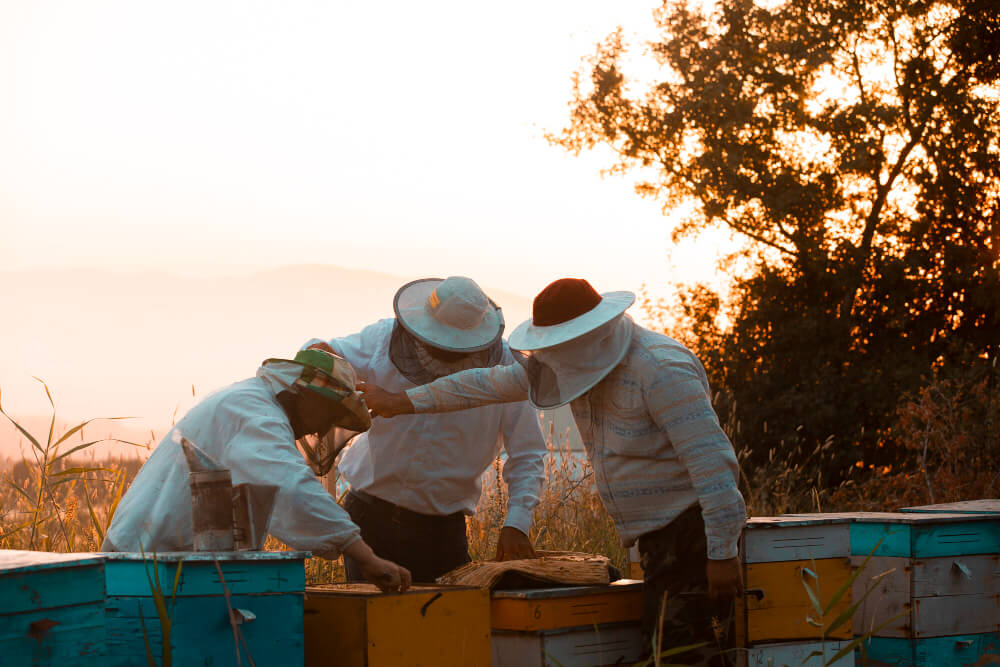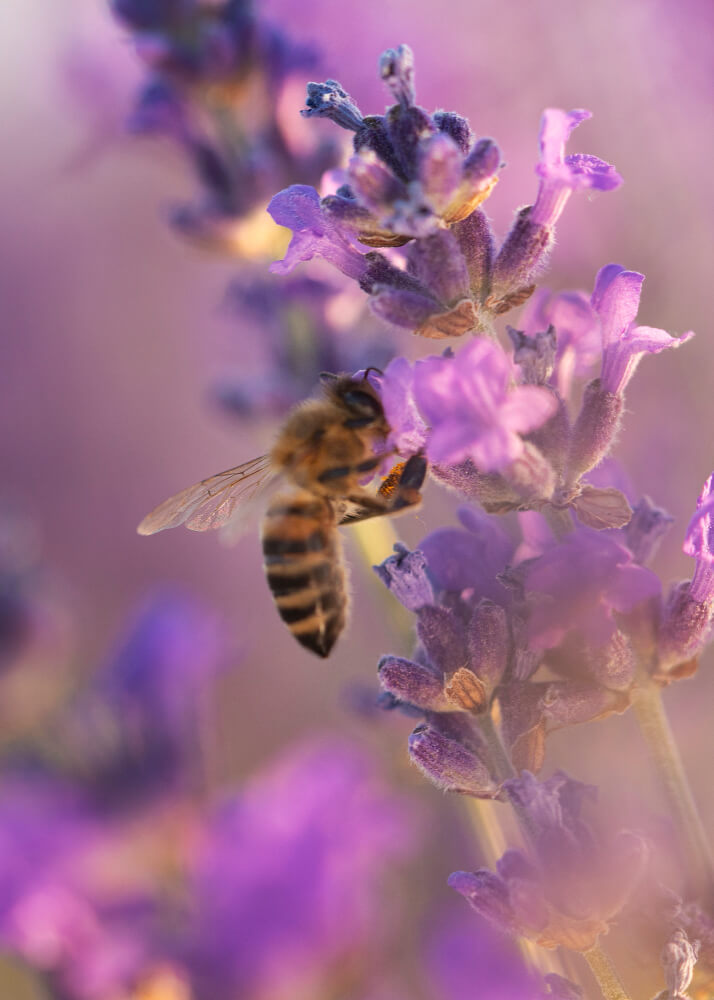Honey bee colonies are delicate ecosystems that rely on a stable supply of nectar and pollen from blooming flowers to sustain their populations and store honey for times of scarcity. However, nature’s bounty is not always consistent, and beekeepers must step in to support their hives during lean periods. This support is crucial, especially during winter and when nectar-secreting flowers are scarce.
In this comprehensive guide, we delve into the essential practice of feeding honey bees to prevent starvation and maintain the health of their colonies. We explore various feeding methods, from dry sugar options to syrup-based solutions, and discuss when and how to feed these remarkable pollinators. By understanding the nuances of bee nutrition and feeding, beekeepers can play a vital role in ensuring the survival and prosperity of honey bee populations.
Let’s embark on a journey through the intricate world of beekeeping, as we discover the art and science of bee feeding, always keeping in mind the well-being of these industrious and essential creatures.

Index:
- Introduction
- Feeding Honey Bees to Prevent Starvation
- The importance of honey stores
- Preventing starvation with various methods
- Monitoring honey stores
- Honey as Feed for Bees
- Safe honey usage
- Legal considerations
- How and When to Feed Bees
- Avoiding open feeding
- Timely sugar syrup or dry sugar placement
- Minimizing bee diseases and robber bee activity
- Feeding Dry Sugar
- Dry sugar for medium to strong colonies
- Sugar crystal liquefaction
- Suitable feeding times
- Transitioning to dry sugar
- Making and Feeding Sugar Syrup
- Sugar-to-water ratios
- Syrup preparation
- Various feeding methods
- Factors influencing feeding frequency
- Additional Feeding Methods
- Shallow tray and frame feeders
- Practical considerations and safety
- Properly Ripened Syrup and Winter Stores
- Syrup moisture content
- Winter store preparation
- Sugar Contamination in Honey
- Managing sugar in combs
- Legal standards and food safety
- Conclusion
- Beekeeper’s role in colony well-being
- Impact of judicious feeding
- Promoting honey bee and ecosystem resilience
Feeding Honey Bees to Prevent Starvation
Honey bees store honey in the hive for various reasons, including:
- Bee feed during winter
- Bee feeding when nectar-secreting flowers are scarce
During times when nectar is in short supply or unavailable, bees rely on their stored honey reserves. Monitoring the honey stores in the hive becomes crucial during these periods because once it’s depleted, the colony faces the threat of starvation.
There are several methods to prevent starvation, such as:
- Moving bees to areas with abundant nectar-producing plants
- Providing them with white table sugar as a bee food
- Offering them syrup made with white sugar
Feeding honey bees with white sugar can effectively keep their colonies alive for extended periods.
Honey as Feed for Bees
It’s essential to exercise caution when considering honey as feed for your bees. Only use honey from your own disease-free hives. This precaution is necessary because honey obtained from unknown sources, like a supermarket or another beekeeper, might contain spores of American foulbrood disease, posing a risk of infection to your hives.
When feeding suitable honey to your bees, ensure it’s placed inside the hive. Never place honey outside the hive, as this practice is illegal under the Livestock Disease Control Act 1994.
How and When to Feed Bees
Leaving sugar syrup or dry sugar out in the open is not advisable. Doing so may lead to your bees feeding from nearby managed and feral colonies, ultimately wasting your resources. Additionally, open feeding can trigger robber bee activity in your apiary and contribute to the spread of bee diseases.
To minimize these risks:
- Place sugar syrup or dry sugar inside the hives towards evening. This timing helps reduce the chances of other bees robbing the hives that have been fed, ensuring that your colony gets the nourishment it needs while minimizing potential issues.

Feeding Dry Sugar
Medium to strong bee colonies have the option of being fed dry white table sugar, which can be placed on hive mats or in trays under the hive lid. However, bees require water to liquefy the sugar crystals. They can source water from outside the hive or use condensation from within the hive. Some beekeepers choose to moisten the sugar with water to prevent it from solidifying, essentially creating a partial syrup.
It’s important to note that weak colonies may not be capable of gathering sufficient water, so dry sugar feeding is not recommended for them.
Regardless of colony size, feeding dry sugar is most effective during the autumn and spring seasons when humidity levels tend to be relatively high. During hot and dry summers, it becomes challenging for bees to dissolve sugar crystals into liquid.
If a colony is on the verge of starvation, it’s advisable to initially feed them sugar syrup before offering dry sugar. This provides the bees with immediate nourishment without the need to liquefy sugar crystals.
In situations where bees have access to enough nectar to meet the colony’s needs, they may not utilize the dry sugar provided. Instead, the sugar may remain within the hive or be deposited by the bees outside the hive entrance. However, in some cases, a small amount of dry sugar may be converted to liquid and stored in the cells.
Making and Feeding Sugar Syrup
There are varying opinions among beekeepers regarding the correct sugar-to-water ratio in syrup. Some prefer a 1:1 ratio of sugar to water (measured by weight), commonly used to:
- Supplement honey stores
- Stimulate colonies for brood rearing
- Encourage comb foundation drawing, especially in spring
Others opt for a denser syrup with a 2:1 ratio of sugar to water for feeding when honey stores in the hive are low. The sugar and water can be measured by either weight or volume, as there’s no need for precise measurements regarding sugar concentration.
Here’s a simple process for preparing and feeding sugar syrup:
- Heat water in a container large enough to hold both water and sugar. Once the water gently boils, remove the container from the heat source and stir in the sugar until it’s fully dissolved.
It’s crucial not to boil the mixture after adding sugar, as boiling can lead to caramelization, making the syrup partially indigestible and toxic to the bees. The syrup should be cooled to room temperature before being fed to the bees.
The cooled syrup can be introduced into the hives through various methods, including:
- Container Feeder with Sealable Lid: Fill a clean container (e.g., jar or tin with a push-down lid) with sugar syrup, drill small holes in the lid, place the filled container on top of wooden risers across the top bars of frames in the top box of the hive, and cover it with an empty super.
- Plastic Bag Feeder: Partially fill a plastic freezer bag with sugar syrup, expel air, tie the bag, and place it on the top bars of frames in the top box of the hive, making sure there’s a bee space between the bag and the hive lid.
- Shallow Tray Feeder: For another feeding method, you can utilize a shallow tray, such as an aluminum foil tray, positioned under the hive lid, containing sugar syrup. However, it’s essential to ensure that bees can access the syrup without falling in and drowning. You can place grass or wood straw (like the type used in cooling devices) in the syrup to serve as a platform. It’s crucial not to use any straw or floating material that has been treated with or in contact with chemicals, as this could pose hazards to the bees. Keeping the hives on level ground helps prevent the loss of syrup, and if the tray isn’t shallow enough, a riser may be necessary.
- Frame Feeder: Another feeding option is a ‘frame or division board feeder,’ which is a container approximately the size of a full-depth Langstroth frame. It features an open top and sits in the super, just like a regular frame. To prevent drowning, you should place flotation material in the feeder to allow bees to access the syrup.
How Often to Feed
Bees typically follow a process of:
- Removing syrup from a feeder
- Reducing the water content
- Storing it in the combs as if it were honey
A medium to strong colony typically depletes the feeder within a matter of days, regardless of the feeder type used. For colonies with minimal stored honey and no incoming nectar, the initial feed quantity is largely determined by factors like the amount of brood, the colony’s size, and to some extent, the size of the syrup container.
It’s generally safer to over-feed a colony than to provide insufficient nourishment, which could potentially lead to the colony’s demise. A typical initial feed ranges from 1 to 3 liters, and regular checks of the combs help determine how much syrup has been stored. This information guides subsequent feedings. Feeding can be ceased once natural nectar becomes available.
Properly Ripened Syrup and Winter Stores
Properly ripened syrup should contain around 18% moisture content. Syrup that hasn’t ripened correctly can ferment and negatively impact the bees. Colonies with insufficient stores for the winter should be given ample syrup to bolster their supplies before the arrival of cold autumn weather. This ensures that bees can fully process the syrup and store it as needed for the winter.
Sugar Contamination in Honey
It’s vital to be cautious about sugar contamination in honey. Sugar left in combs must not be extracted with the next honey crop, as it can compromise the honey’s quality and its adherence to legal standards set out in the Australia New Zealand Food Standards Code – Standard 2.8.2 – Honey.
Ideally, the sugar you provide to the hive should be entirely consumed by the bees when they are placed on a honey flow. However, achieving this may not always be possible. During the expansion of the brood nest, sugar stored in brood nest combs might be relocated by the bees to the honey super.
Conclusion: Nurturing the Life of Honey Bee Colonies
As stewards of these remarkable pollinators, it’s our responsibility to safeguard the health and vitality of honey bee colonies. In times of nectar scarcity and winter’s chill, the judicious practice of bee feeding can make all the difference.




